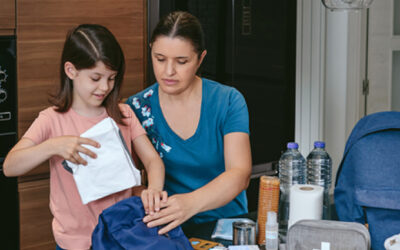Torticollis is Latin for “twisted neck,” and it’s a condition infants can experience due to their position in the womb or after a difficult childbirth. Physical therapist Stephanie Wilks, PT, DPT, OCS, helps us understand this fairly common condition and what parents should do.
Eighty percent of torticollis in infancy is determined to be muscular in origin or congenital muscular torticollis. In the remaining 20 percent, the torticollis posture may indicate a more serious underlying condition. Accurate identification of a muscular cause is important in diagnosing congenital muscular torticollis.
Congenital muscular torticollis typically results from tightness in a specific muscle in the neck. This muscular tightness causes a child’s head to tilt toward one shoulder while causing his or her face to turn toward the opposite shoulder.
Torticollis limits a child’s ability to turn their head in order to see, hear and interact freely with their environment.
Because of these limitations, torticollis may lead to delayed learning, poor body awareness, decreased muscle strength and poor balance. Babies with torticollis are also very likely to develop a flattening of the back of the head or the side of the face. This is called plagiocephaly, which can also lead to developmental delays.
Supervised Tummy Time is Key
Babies who do not spend enough time on their tummy are at risk of delays in motor development.
Studies show children with congenital muscular torticollis and plagiocephaly can decrease their risk of delayed development by spending supervised time on their tummies. This playing position helps promote head and neck control.
Treatment for Torticollis
Torticollis and plagiocephaly should be thoroughly evaluated by a physician to determine the cause and whether treatment is necessary. Your child should be screened for motion and end feel of the head and neck, visual function, head shape, hip symmetry and age-appropriate reflexes. If congenital muscular torticollis is diagnosed, physical therapy is typically recommended.
Studies show that 90 percent of children achieve a good to excellent outcome with physical therapy. The best results occur when therapy begins as early as possible. Physical therapy will include stretching for the head and neck, strengthening activities for the head and trunk, and parent education to promote optimal development for the child.
Helping At Home
- Position yourself and your baby’s toys on the opposite side of their preference.
- Set up your baby’s environments—toys, crib, play mat, etc.—to encourage them to explore their non-preferred side.
- When placing your baby in a seat or swing, place a small, rolled towel on the tilted side of their head to help support a more neutral head position.
- Alternate how the baby is held and fed to encourage exploration toward the non-preferred side.




